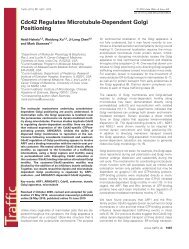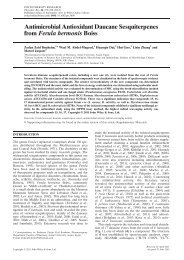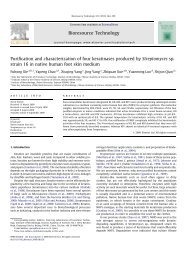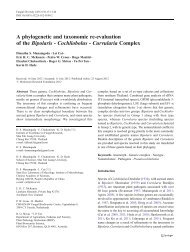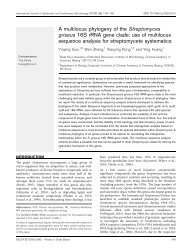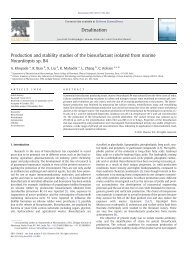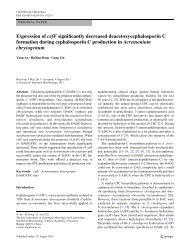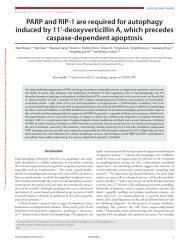Biochemical and structural characterization of Cren7, a novel ...
Biochemical and structural characterization of Cren7, a novel ...
Biochemical and structural characterization of Cren7, a novel ...
Create successful ePaper yourself
Turn your PDF publications into a flip-book with our unique Google optimized e-Paper software.
1132 Nucleic Acids Research, 2008, Vol. 36, No. 4<br />
Figure 2. Interaction <strong>of</strong> <strong>Cren7</strong> with DNA in vitro. (A) Comparison <strong>of</strong> binding <strong>of</strong> <strong>Cren7</strong> to dsDNA <strong>and</strong> ssDNA. Recombinant <strong>Cren7</strong> was incubated<br />
with a radiolabeled 60 bp dsDNA or 60 nt ssDNA. Protein–DNA complexes were subjected to electrophoresis in polyacrylamide. Protein<br />
concentrations were 0, 0.02, 0.04, 0.08, 0.16, 0.31, 0.63, 1.3, 2.5, 5 <strong>and</strong> 10 mM, respectively. (B) Effect <strong>of</strong> binding by <strong>Cren7</strong> on thermal stability <strong>of</strong><br />
dsDNA. Thermal denaturation <strong>of</strong> poly[dAdT]–poly[dAdT] in the presence <strong>and</strong> absence <strong>of</strong> <strong>Cren7</strong> was determined by monitoring changes in UV<br />
absorbance at 260 nm. (C) Nick closure analysis <strong>of</strong> the ability <strong>of</strong> <strong>Cren7</strong> to constrain DNA supercoils. Single-nicked plasmid pBR322 was incubated<br />
with <strong>Cren7</strong> at various protein/DNA mass ratios <strong>and</strong> ligated with T4 DNA ligase at 258C. Samples were deproteinized <strong>and</strong> subjected to agarose gel<br />
electrophoresis. Lane 1, negatively supercoiled pBR322; lane 2, single-nicked pBR322; lanes 3–10, topoisomers <strong>of</strong> pBR322 ligated in the presence <strong>of</strong><br />
<strong>Cren7</strong> at the following protein/DNA mass ratios: 0, 0.05, 0.1, 0.15, 0.2, 0.25, 0.375 <strong>and</strong> 0.5, respectively. N, nicked circular plasmid; L, linear<br />
plasmid; S, supercoiled plasmid. (D) Plot <strong>of</strong> the linking number change <strong>of</strong> nick-closed plasmid against the <strong>Cren7</strong>/DNA mass ratio. The linking<br />
change <strong>of</strong> pBR322 ligated in the presence or absence <strong>of</strong> <strong>Cren7</strong> was measured by resolving topoisomers on agarose gels in the presence or absence <strong>of</strong><br />
chloroquine <strong>and</strong> b<strong>and</strong> counting.<br />
resolvable shifts <strong>and</strong>, after a binding ratio <strong>of</strong> 10 bp per<br />
protein molecule was reached, formed increasingly slowmigrating<br />
smears as protein concentration increased<br />
(Figure 2A). Therefore, the gel retardation pattern <strong>of</strong><br />
<strong>Cren7</strong> was biphasic, with a low-binding density phase <strong>and</strong><br />
a high-binding density one. <strong>Cren7</strong> probably bound to<br />
DNA with a binding site size <strong>of</strong> 10 bp in the low-binding<br />
density phase, but switched to a new binding mode in<br />
the high-binding density phase. This new binding mode<br />
presumably involved a change in protein–DNA <strong>and</strong>/or<br />
protein–protein contacts. The inability to resolve large<br />
<strong>Cren7</strong>–DNA complexes formed at high protein concentrations<br />
by EMSA prevented an accurate determination,<br />
based on the relationship between the maximum number<br />
<strong>of</strong> shifts <strong>and</strong> the size <strong>of</strong> the dsDNA fragment, <strong>of</strong> the<br />
binding site size <strong>of</strong> the protein in the high-density-binding<br />
phase. However, judging from the lowest protein/DNA<br />
ratio at which plasmid pBR322 was maximally retarded<br />
by <strong>Cren7</strong> in an agarose gel, we obtained a binding density<br />
<strong>of</strong> 3 bp per protein molecule for the high-density-binding<br />
mode (data not shown). In comparison, no biphasic gel<br />
retardation pattern was observed for Sul7d, which has<br />
a binding site size <strong>of</strong> 3.3–4.6 bp (13,26). Both native<br />
S. shibatae <strong>Cren7</strong> <strong>and</strong> recombinant S. solfataricus <strong>Cren7</strong><br />
showed similar affinities for the dsDNA fragment with<br />
apparent dissociation constants (K D ) between 0.08 <strong>and</strong><br />
0.16 mM under low salt conditions (data not shown).<br />
Therefore, the binding affinity <strong>of</strong> <strong>Cren7</strong> for DNA was<br />
not affected by the post-translational modifications <strong>of</strong><br />
the protein. In addition, the <strong>Cren7</strong> proteins from the two<br />
Sulfolobus species showed no detectable differences in<br />
DNA binding, as expected from the fact that the two<br />
proteins are nearly identical, differing only at one amino<br />
acid position (A7 in the former <strong>and</strong> P7 in the latter)<br />
in a nonconserved region (Figure 1B). We also found<br />
that the protein showed little sequence specificity in DNA<br />
binding since similar gel retardation patterns were generated<br />
when DNA fragments <strong>of</strong> different sequences were<br />
used (data not shown).<br />
Like Sul7d, <strong>Cren7</strong> bound only weakly to ssDNA<br />
(apparent K D = 2.5 mM) in low salt, <strong>and</strong> generated no<br />
resolvable shifts on a labeled ssDNA (Figure 2A) (12,13),<br />
indicating that <strong>Cren7</strong> binds preferentially to dsDNA over<br />
ssDNA. This observation suggests that <strong>Cren7</strong> might affect<br />
the T m <strong>of</strong> dsDNA. Indeed, we found that the T m <strong>of</strong><br />
poly[dAdT]–poly[dAdT] was raised by 23.38C <strong>and</strong> 28.88C,<br />
respectively, in the presence <strong>of</strong> <strong>Cren7</strong> at protein/DNA<br />
mass ratios <strong>of</strong> 1 <strong>and</strong> 5 (Figure 2B). So, binding by <strong>Cren7</strong><br />
significantly increased the stability <strong>of</strong> dsDNA against<br />
thermal denaturation.





